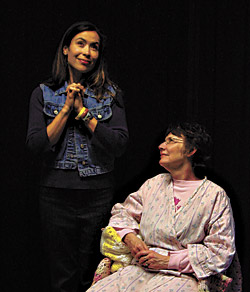I KNEW AN award-winning documentary filmmaker who joked that he had a sixth sense about when he was approaching a neighborhood where interview subjects would be found: “We’re in Victimville! I can feel it!” He was right to be cynical: Documentaries are often rewarded by earnest nerd judges for worthy, simplistically formulaic stories of the downtrodden, especially people of color.
You might think Gail Dolgin’s and Vicente Franco’s Daughter From Danang (which runs Friday, Jan. 24 through Thursday, Jan. 30 at the Varsity) would fit this description. It doesn’t. It’s not about victims, and it offers no simple, heartwarming answers. It’s the utterly absorbing, rigorously unsentimental account of a child, fathered by an American GI and whisked out of Vietnam in 1975 at age 7 as part of President Ford’s “Operation Babylift.” She’s adopted by a single mom in Pulaski, Tenn., who calls her Heidi; and 22 years later, she reunites with her biological mom in Danang.
Abandoned by her husband, who joined the Viet Cong, Heidi’s mother, Mai Thi Kim, went to work at a U.S. Army base and accepted a GI’s offer of sex in return for support for her kids. The GI shipped home when she was pregnant with his daughter, whom she named Mai Thi Hiep (Hiep means “united”). In 1975, when half-American kids were being burned alive, she sent Hiep to America, possibly trading one kid to save the rest and herself.
Operation Babylift turns out to have been an incompetent mess and Heidi’s adoptive mom a cold, abusive nightmare who disowned her for life after Heidi arrived from a date five minutes late. Heidi, a bubbly lass reminiscent of Valerie Bertinelli, was raised to be a total Southern belle, denying her racial identity in a town that was the birthplace of the Ku Klux Klan (there’s still an annual parade).
Though the KKK horrifies Heidi, she’s proud to be “101 percent Americanized,” and as she discovers upon returning to Danang, a huge cultural gulf now separates her from her bio-relatives. Heidi’s family moves around, from Tennessee to Rhode Island; for the Vietnamese, the highest value is to stay rooted right where you are, on the farm where your ancestors are buried. Brilliantly and intimately, the film shows the ghastly collision when Heidi comes “home” to Danang, adorned with and handing out expensive rings to her impoverished clan.
After initial hugs and tears, Heidi confesses to the camera that her mom’s clinginess is getting disturbing. When her family demands that she share her wealth like a dutiful Vietnamese daughter, the tears turn scalding. To Heidi, it’s a brutal betrayal; to her mom and siblings, Heidi was betraying family tradition. They buried her placenta on their farm when she left! This is where she (and her money) belongs! Her mom reassures her that she doesn’t have to come to her senses immediately: Family is “forever.” When last we see her mother, she’s praying to Heidi’s grandmother’s photo, vowing that one day Heidi’s kids will come home to Danang to build their great-grandmother a tomb.
Heidi sobs, “I wish I could turn back the clock and not know any of this.” A very American wish: History is now, and the past shouldn’t matter. Who is the victim? Everyone and no one.









